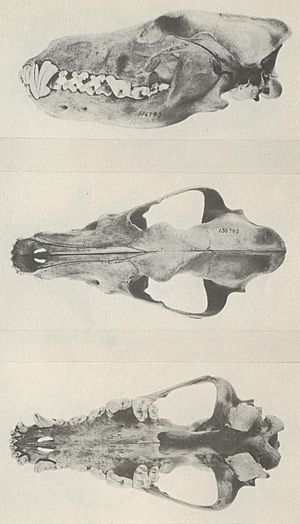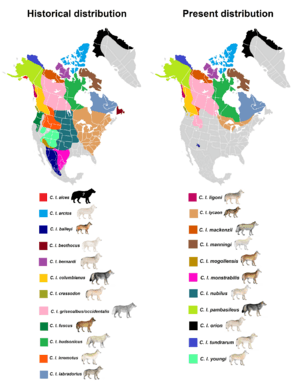Kenai Peninsula wolf facts for kids
Quick facts for kids Kenai Peninsula wolf |
|
|---|---|
 |
|
| Conservation status | |
|
Extinct (1925)
|
|
| Scientific classification |
|
| Kingdom: | Animalia |
| Phylum: | Chordata |
| Class: | Mammalia |
| Order: | Carnivora |
| Family: | Canidae |
| Genus: | Canis |
| Species: | |
| Subspecies: |
†C. l. alces
|
| Trinomial name | |
| Canis lupus alces Goldman, 1941
|
|
 |
|
| Historical and present range of gray wolf subspecies in North America | |
The Kenai Peninsula wolf (Canis lupus alces) was a special type of gray wolf. It lived on the Kenai Peninsula in southern Alaska. Sadly, this wolf is now extinct, meaning there are no more of them alive today. It was also known as the Kenai Peninsula grey wolf.
Contents
History of the Kenai Peninsula Wolf
Discovery and Extinction
A scientist named Edward Alphonso Goldman officially named this wolf a subspecies in 1941. It was one of four different wolf types found in Alaska at that time. This wolf is still recognized as a unique subspecies of Canis lupus by scientists today.
Before the year 1900, many wolves lived on the Kenai Peninsula. But in 1895, gold was discovered there. Many miners came to the area. They worried about diseases like rabies from the wolves. Because of this fear, people started hunting, trapping, and poisoning the wolves.
By 1915, almost all the wolves were gone from the peninsula. The Kenai Peninsula wolf was officially declared extinct in 1925. This means it had completely disappeared from the Earth.
Wolves Return to the Peninsula
New wolves did not return to the Kenai Peninsula until the 1960s. These new wolves came from other parts of Alaska. Scientists have studied the DNA of the wolves living there now. Their studies show that today's wolves on the Kenai Peninsula are related to other Alaskan wolf types. This means the original Kenai Peninsula wolf did not come back. Instead, new wolves moved in and started new families.
Description of the Kenai Peninsula Wolf
Size and Diet
The Kenai Peninsula wolf was known for being very large. Scientists believe its big size was an adaptation. This means it grew large to help it hunt the very big moose that lived in the region. These moose were its main food source.
Where to See a Skull
You can still see a skull of a Kenai Peninsula wolf today. The Smithsonian Museum has one in its collection. Its special number is USNM 147471.
See also
 In Spanish: Lobo gigante de Kenai para niños
In Spanish: Lobo gigante de Kenai para niños

